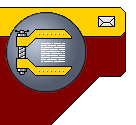Сайт о сжатии >> ARCTEST
Сравнительные тесты Альтернативные тесты
|
|
|
|
|
|
|
|
|
|
|
|
|
|
|
|

|
 |
||
|
Сайт о сжатии >>
Новинки |
О сервере
(Compression Catalog! |
ENGLISH)
Книга "Методы сжатия данных" >> Без потерь | Изображений | Видео Разделы >> Cтатьи | Видео | Arctest | Ссылки | Ru.compress | Форум Проекты >> Д.Ватолина | А.Ратушняка | М.Смирнова | В.Юкина | Е.Шелвина | Д.Шкарина |
||
AR7
Unlike the output from most archivers, ar7 archives are regular 7-bit, ASCII files with lines 78-characters or less long.
This means they can be mailed through electronic mail services that strip the eighth bit and don't like special characters such as CTRL-Z, etc.
ar7 also ignores all lines before it reaches its specially coded data area, so if your e-mail service attaches headers to your messages, these can be simply left on the archive and will not affect anything
You may also add lines of text (description of contents, etc.) to the beginning of the file by editing it with nearly any text editor.
Text may also be added after the final "!$" of the ar7 data area.
You just need to be sure that you do not add any lines that begin with a comma (ar7's signal). The text on this line may be edited; it is displayed on the screen whenever ar7 opens the archive.
The compaction rates of ar7 are not too astonishing, even though it uses a very efficient compression routine. The archives generally average about 60-90% the size of the original files. This is due to the restriction of it using editable, e-mailable ASCII files. So I doubt it will be used much except for 7-bit e-mail systems.
Сайт о сжатии
>>
ARCTEST
>>
Сравнительные тесты
|
Альтернативные тесты
|
Графические тесты
|
Новости
|
Утилиты
|
Файл'менеджеры
|
Описания
|
Линки
|
Necromancer's DN
|
Поддержка
|
|
Сайт о сжатии >>
Новинки | О сервере | Статистика
Книга "Методы сжатия данных" >>
Универсальные | Изображений | Видео
Разделы >> Download (статьи+исходники) | Ссылки | Ru.compress | Arctest | Видео | Каталог ссылок | Форум
Проекты >> Д.Ватолина | А.Ратушняка | М.Смирнова | В.Юкина | Е.Шелвина | А.Филинского | Д.Шкарина | С.Оснача